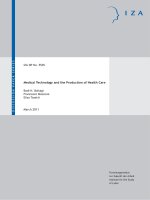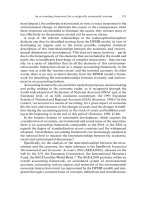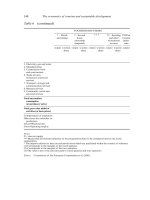The economics of health and health care 7th edition folland test bank
Bạn đang xem bản rút gọn của tài liệu. Xem và tải ngay bản đầy đủ của tài liệu tại đây (154.8 KB, 10 trang )
Chapter 2 – Microeconomic Tools for Health Economists
Key Ideas
An equilibrium is an important economic concept. If we are not in equilibrium, we
go to equilibrium. If we are in equilibrium, we stay there. This affects supply and
demand, as well as individual, and firm level behaviors.
Elasticities provide valuable information. We know that if price rises, quantity
demanded will go down, but will it go down a little or a lot? Elasticities tell us.
Instructors must emphasize that elasticities refer to percentage changes rather than
slopes.
Economic optima occur when marginal cost (the cost to produce) equal price (the
value to the consumer). Perfect competition takes us to these optima; monopolies do
not.
Economic optima are about quantity. Monopolies are “bad” not because they provide
positive monopoly profits, but because the wrong quantity is produced. Externalities
are “bad,” again, because the wrong quantity is produced.
Teaching Tips
Instructors may wish to “pick and choose” topics through this chapter, or to use the
chapter as a reference. It is not designed to be self-contained course in
microeconomic analysis.
There are several instances here where simple spreadsheet programs can show how
equilibria or elasticities are calculated. Figures 2-3 or 2-4 can be drawn and shifted to
show changes in equilibria.
For elasticities, price and quantity coordinates can be used to compute the values of
demand elasticities. If these are linked (in the program) to graphs, then one sees that
the steeper the demand curve, the less elastic it is.
Chapter 2 – Microeconomic Tools for Health Economists - Multiple Choice
Society’s Trade-off between Guns and Butter
Point
Butter
Guns
A
B
C
D
E
F
850
800
700
550
z
0
0
100
200
300
400
500
Opportunity Cost for 100 Guns
x
100
150
250
300
1. In the above table, calculate the opportunity cost x (in foregone butter) for the first
100 guns.
a.
b.
c.
d.
10 units of butter
50 units of butter*
100 units of butter
200 units of butter
2. In the table above, calculate output of butter z that is consistent with the opportunity
cost of 250 units of butter.
a.
b.
c.
d.
400 units of butter
350 units of butter
325 units of butter
300 units of butter*
____________________________________
Market for Apples
____________________________________
Price Quantity Demanded
10
8
6
4
2
100
200
300
400
500
Quantity Supplied
500
400
300
200
100
3. At a price of $4 per bushel, demanders are willing to buy ____ bushels, for total
expenditures of _______.
a.
b.
c.
d.
400; $400.
200; $1600.
300; $1800
400; $1600*
4. At a price of $8 per bushel, suppliers are willing to provide ____ bushels, for total
expenditures of _______.
a.
b.
c.
d.
400; $3200.*
300; $1800.
200; $ 800.
100; $ 100.
5. In the market above, the equilibrium price is ____ dollars per bushel, and the
equilibrium quantity is _____ bushels:
a.
b.
c.
d.
2; 500
3; 400
6; 300*
10; 500
6. Suppose that in the market above, a new technology allows suppliers to supply 50
more bushels at each price (for example, at a price of $10, 550 bushels of apples will
be supplied). Compared to problem 5:
a.
b.
c.
d.
equilibrium prices and quantities will remain unchanged from earlier.
equilibrium price will fall and equilibrium quantity will rise.*
equilibrium price will rise and equilibrium quantity will fall.
equilibrium price and quantity will both rise.
7. Suppose that in the market above, there is a lack of rainfall, shrinking the crop of
apples. At the same time a government report urges people to eat apples rather than
junk food. Compared to problem 5:
a.
b.
c.
d.
equilibrium prices and quantities will remain unchanged from earlier.
equilibrium price will rise and equilibrium quantity will rise.
equilibrium price will rise and equilibrium quantity may rise or fall. *
equilibrium price and quantity will fall.
8. As Kathy’s wealth increases:
a.
b.
c.
d.
her total utility increases.*
her marginal utility of wealth increases
her average utility of wealth increases
none of the above are true.
G
Beef
Chicken
C
A
B
0
D
Chicken
9. On the graph above, the curved lines refer to:
a.
b.
c.
d.
downward sloping demand curves
indifference curves where utility is constant*
marginal utility curves, relating beef to chicken
total utility curves relating income to chicken
10. Suppose that the consumer is at point B. Line GE represents:
a.
b.
c.
d.
the demand for chicken.
the demand for beef.
the consumer’s budget constraint.*
the supply of chicken.
E
F
11. Suppose at point B that chicken increases in price and beef does not. Which point
represents the most plausible new equilibrium for the consumer?
a.
b.
c.
d.
point A*
point B
point E
point F
12. An increase in income at point B is represented by:
a.
b.
c.
d.
an inward rotation of the budget constraint at point G.
an outward rotation of the budget constraint at point G.
a parallel inward shift of the budget constraint.
a parallel outward shift of the budget constraint.*
13. As drawn, decreases in the price of chicken lead the consumer from point B to point
C to point D. At point D, compared to point B:
a. consumers have increased their consumption of chicken, but decreased their
consumption of beef because its price has not decreased.
b. consumers have increased their consumption of chicken and beef because their
tastes for beef have changed.
c. consumers have increased their consumption of chicken and beef because the fall
in the price of chicken has freed up income to spend on beef.*
d. the relative amounts of chicken and beef are unchanged.
Market
Demand
or Supply
Quantity
0
Quantity
14. Draw the following demand curve on the graph above:
Quantity Demanded = 30 – 1.5*Price
a.
b.
c.
d.
If the market price equals 6, quantity demanded equals 15.
If the market price equals 8, quantity demanded equals 18.
If the market price equals 12, quantity demanded equal 12.
Answers (b) and (c) are correct.*
15. Draw the following supply curve on the graph above.
Quantity Supplied = -6 +2.5 * Price
a.
b.
c.
d.
If the price equals 3, quantity supplied will be 1
If the price equals 4, quantity supplied will be 2.
If the price equals 6, quantity supplied will be 9.*
If the price equals 10, quantity supplied will be 15.
16. Using these equations, calculate the equilibrium price and quantity.
Quantity Demanded = 30 – 1.5*Price
Quantity Supplied = -6 +2.5 * Price
a.
b.
c.
d.
Price = 14; Quantity = 9
Price = 10; Quantity = 17.5
Price = 9; Quantity = 16.5*
Price = 5; Quantity = 20.
17. In problem 16, if demand increases and supply increases:
a.
b.
c.
d.
equilibrium quantity will increase, and equilibrium price will stay the same
equilibrium quantity will increase, and equilibrium price may rise or fall.*
equilibrium price will increase, and equilibrium quantity will stay the same.
equilibrium price will decrease, and equilibrium quantity may rise or fall.
18. In many cases, diabetics require the drug insulin. If they do not get it they will die.
From this information, we would guess that the price elasticity of demand is
approximately:
a. – 20.0
b.
–1.0
c.
–0.5
d.
0.0*
19. Suppose that twin eye doctors work across the hall from each other. Even their
parents have trouble telling them apart, and they both went to the same medical
school. From this information, we would guess that the price elasticity of demand for
either of their services is closest to:
a. – 20.0*
b.
–1.0
c.
–0.5
d.
0.0
20. If the income elasticity of demand is +0.7, a 10% increase in income will ______.
a.
b.
c.
d.
decrease expenditures by about 7%.
increase expenditures by about 7%.*
leave expenditures unchanged.
The answer cannot be determined.
21. If the price elasticity of demand is –0.5, a 10% increase in price will ______.
a.
b.
c.
d.
decrease expenditures by about 5%.
increase expenditures by about 5%.*
leave expenditures unchanged.
The answer cannot be determined.
Production Schedule for MRIs.
Capital
Labor
Quantity
MP(labor)
AP (labor)
10
10
10
10
10
10
0
1
2
3
4
5
0
3.98
5.25
6.18
6.93
7.58
3.98
1.27
_____
_____
_____
3.98
2.62
2.06
____
____
22. Using the above table, we can determine that the marginal product of labor ______.
a.
b.
c.
d.
falls to 0 by the fourth worker
falls and then rises to 7.58
falls to 0.75 by the fourth worker*
cannot be calculated past the second worker.
23. Using the above table, with 5 laborers, the MP = _____, and the AP = _____.
a.
b.
c.
d.
0.65; 1.52. *
1; 2.
5; 10.
cannot be calculated past the second worker.
24. Using the above table, we can determine that the average product of labor ________.
a.
b.
c.
d.
will increase the more labor is used
will decrease the more labor is used
will decrease as long as the amount of capital is kept constant
Answers (b) and (c) are correct.*
25. The marginal cost curve:
a.
b.
c.
d.
always cuts the minimum of the total cost curve
always cuts the minimum of the average cost curve*
is always situated below the demand curve
Answers (b) and (c) are correct.
MC
Price
AC
P1
C
P3
B
P2
A
MR
Q1
Q2
Demand
Q3
Quantity
26. In the diagram directly above, marginal revenue is less than price because:
a.
b.
c.
d.
perfect competition affects monopolists differently than competitors.
monopolists must charge consumers more to earn higher profits
monopolists must lower prices to existing customers in order to sell more units.*
Answers (b) and (c) are correct.
27. In the diagram directly above, in contrast to a perfect competitor, who equalizes
marginal cost and product price, the monopolist optimizes at ________.
a.
b.
c.
d.
point A.*
point B.
point C.
maximum price.
28. If there was perfect competition in the industry, total economic profits would be:
a.
b.
c.
d.
zero*
positive because firms must earn profits to stay in business.
positive because price exceed average costs.
negative because competition forces firms to lower prices to stay in business.
29. In the diagram above, if there was perfect competition in the industry, the market
price would be:
a.
b.
c.
d.
P1.
P2.*
P3.
None of the above.
30. In the diagram above, the “welfare loss” of monopoly occurs because price
__________.
a. P2 is lower than the competitive price; and the quantity Q2 is higher than the
competitive quantity.
b. P3 does not equal average cost.
c. P1 is higher than competitive price, and quantity Q1 is lower than competitive
quantity.*
d. P2 does not equal marginal cost.









